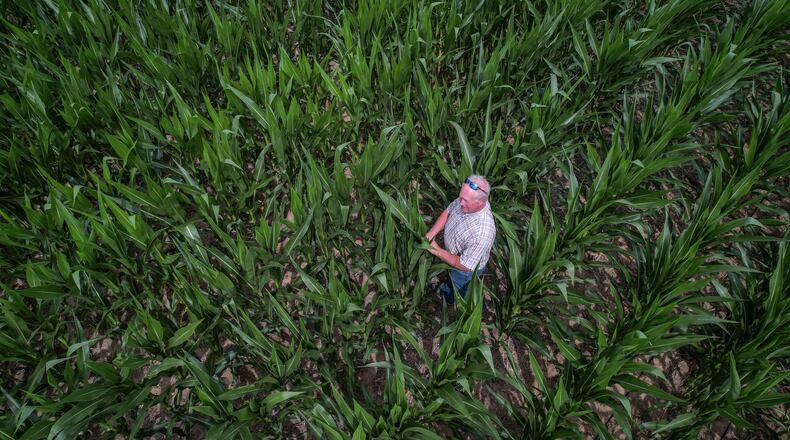June was a dry month for farms in the region and farmers are hoping for a little rain, not much between a half-inch and inch, in the next 10 days in hopes of having a decent harvest in 2022
This year’s planting season got off to a slow start due to a cold and rainy April and May which delayed planting their crops during a time of higher diesel fuel and fertilizer costs that have gone through the roof. While June has been a very warm month, the infrequent rains are making it harder for the crops to develop and grow.
The crazy weather also has some Ohio farmers planting a second time because of the lack of rain.
Need rain now
Ty Higgins, Ohio Farm Bureau spokesman, said the wet early spring and the hot June is causing stress with the crops and the farmers trying to have a successful harvest this fall.
“Over one-third of the corn, soybean and wheat crops are in and it’s in fair condition,” he said. “A lot of farmers had second plantings because the first plantings did not emerge out of the ground. There’s been no rain and the conditions are not good.”
Higgins said there have been times before when farmers were still planting corn during the first week of July. He said it’s too early to know how the 2022 weather will affect the crops.
“Every field is looking for something to drink in southwestern Ohio,” he said. “We’re about 2 inches below the average rain in June and that’s not conducive to growing crops. Some rain would go a long way if the crops are in the ground.”
Slow start of planting season as farmers work to catch up
On Thursday, the U.S. Department of Agriculture issued its Ohio Acreage Summary, noting the slow, cold and wet start to the 2022 planting season but that Ohio farmers had made progress and were able to catch up to the five-year crop planting averages by Memorial Day.
Despite the efforts by farmers, Cheryl Turner, USDA state statistician for the Ohio Field Office, said Ohio field crop producers planted fewer acres of corn in 2022 than in 2021.
As of Thursday, Ohio corn growers planted 3.4 million acres this year, down 150,000 acres in 2021. Corn harvested for grain is projected to be 3.17 million acres this year which is down 170,000 acres.
Ohio’s soybean growers planted 4.95 million acres, up 50,000 from 2021. Harvested acres of soybeans are anticipated to be 4.93 million acres.
Ohio winter wheat growers planted 530,000 acres of wheat, 50,000 acres fewer than last year. Area harvested and to be harvested for grain totaled 480,000 acres, down 7 percent from last year.
Credit: JIM NOELKER
Credit: JIM NOELKER
Nationally, corn planted area for all purposes in 2022 is estimated at 89.9 million acres, down 4 percent or 3.44 million acres from last year. Compared with last year, planted acreage is expected to be down or unchanged in 35 of the 48 estimating States. Area harvested for grain, at 81.9 million acres, is down 4 percent from last year.
U.S. soybean planted area for 2022 is estimated at 88.3 million acres, up 1 percent from last year. Compared with last year, planted acreage is up or unchanged in 24 of the 29 estimating States.
The 2022 winter wheat planted area in the U.S., at 47.1 million acres, up 1 percent from 2021. The 2022 winter wheat planted area, at 34.0 million acres, is up 1 percent from last year, but down 1 percent from the previous estimate. Of this total, about 23.5 million acres are Hard Red Winter, 6.86 million acres are Soft Red Winter, and 3.61 million acres are White Winter.
On June 27, Turner reported the dry weather resulted in early signs of crop stress.
Miami Valley farmers playing the cards dealt by Mother Nature
Craig Corry, a Greene County farmer, said “crop reports have been all over the board.”
“Our crops are looking good but we really need some rain,” he said. Last weekend we saw signs of winter wheat stress. Fortunately we got an isolated shower that helped things.”
Corry said corn will try to conserve moisture as its leaves roll into a ball and get tight like a pineapple. He said when soybeans are in stress, the plant leaves begin to cup due to the lack of moisture and loses some of its color. He farms about 500 acres.
“All it takes is a good rain to bring everything back to normal,” he said. “There’s a lot of growing season left to go and a lot of late planted corn. Corn can compensate if there is enough moisture and sunshine to provide some heat.”
When asked if his corn will be knee-high by the Fourth of July, Cory said some will be knee-high and some will be shoulder-high depending on when the crop got into the ground. He said there will be some farmers with both because of the circumstances.
“About every 10 years we get hit by a weather cycle,” he said. “We play the hand we’re dealt. Farmers feel pretty good if they produce a crop.”
Michael Brehm farms about 2,900 acres in Darke County with growing corn taking 40% and soybeans taking 60% of his acreage. He said he had to plant a second time because of the weather earlier this spring where the crops were flooded out.
“We haven’t had rain in three weeks and everything is stressing due to the heat,” he said. “The late corn planted is not so good but it may be knee-high by the Fourth of July. We desperately need an inch of rain in the next week.”
However, Brehm said the cool nights in the past few days have helped corn relax. He said he has planted a lot of soybeans two weeks ago. He’s anticipating a 10% to 15% loss on the yield of both crops. He said it’s hard to replant where the holes are in the fields after a certain date.
Another Darke County farmer, Dean Thompson said he has several corn fields planted and the heat has been good for his soybeans. He completed his planting two weeks ago and said his corn will be taller than knee-high by today.
“The soybeans coming up need some rain,” Thompson said. “A nice easy inch will be good for everyone’s crops.s.”
During the dry spell, Thompson said he’s been able to do some spraying and adding nitrogen to the soil.
“Farmers have learned that the window of opportunity is narrow,” he said. “You have to gear up and whatever it takes to get it done.”
Tim Hesselbrock, a Butler County farmer and president of the Butler County Farm Bureau, also said farmers need rain soon. He said some areas of the county have received some rain, but not everywhere. Hesselbrock said the rain is needed to keep things growing.
Another Butler County farmer, Gail Lierer, agreed saying she’d be happy with some timely rains -- about a half-inch and spaced out over a few days. She said her corn and soybean crops are progressing and would do even better with some rain.
About the Author


